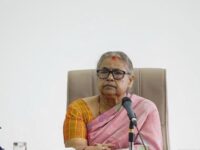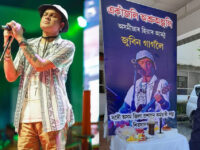As the Durga Puja festival begins on Monday, the Chaltabagan Sarbojanin Durga Puja in Kolkata’s Machuabazar pays tribute to the mother tongue Bengali: “Ami Banglai Bolchi” – I am speaking in Bengali.
At the entrance of the pandal is a tree of languages depicting the linguistic roots and historical stages of modern Bengali. The artist who has created it, Pradipta Karmakar, said the genealogical representation of the evolution of Bengali shows that all mother tongues, not just Bengali, should be respected.
At the back, a group of actors perform a play inspired by filmmaker Satyajit Ray’s acclaimed movie Hirak Rajar Deshe, The Land of the Diamond King. In conversations between the king and a jester, they underline the importance of the Bengali language.
It is a reminder that Bengal’s Durga Puja pandals have a long history of tapping into the current debates, addressing political and social discussions head-on.
Since May, the targeting and forced expulsion into Bangladesh of Bengali-speaking Muslim migrant workers has put the linguistic and cultural Bengali identity at the forefront of a discussion about Indian citizenship and belonging.
Early in August, West Bengal Chief Minister Mamata Banerjee had criticised a letter purportedly issued by the Delhi Police for referring to Bengali as “Bangladeshi language”. On September 2, during a special session of the state assembly called to condemn the targeting of Bengali-speaking migrant workers, Banerjee accused the Bharatiya Janata Party of being “anti-Bengali.”
The rituals of this festival have been the long-time target of the BJP, which has frequently complained that Bengalis often “disrespect” Hinduism by deviating from the scriptures in the conceptions of the idol of the goddess, eating non-vegetarian food during the festivity and in the themes of the pandals.
The controversy has found expression in the Durga Puja festival this year. In addition to the Chaltabagan Sarbojanin Durga Puja, several other puja pandals in Kolkata have focused on Bengali identity, cultural history and migration.
Some showcase detailed history and make global comparisons, while others reflect local issues to highlight the personal.
This year, the Aswininagar Bandhumahal pandal in Baguihati in North Kolkata, maps the history of Bengalis in the lattice work of its tree display, showing how they migrated and came to live in the riverine geographies of what is now known as Bengal.
The theme is “Bangla O Bangali’r Samriddhir Adyopanto”, which means “the beginning to end of Bengali and Bengal’s prosperity”.
The pandal offers a well-researched representation of the myriad changes of power in Bengal. Can the Bengalis relate to the African-Nordic community? This pandal offers an answer.
In Thakurpukur in South Kolkata, the Durga Puja of the State Bank Club is inspired by the excavation site at Moghalmari in Dattan in West Medinipur, where the remains of an ancient Buddhist monastery were found. The theme is “Protno Kotha”, old tales, to remind the Bengalis of their ancient past.
Committee member Professor Debalina Seth said the display addresses two topics: “the misconception that Bengal has no history and the need to acknowledge the importance of Moghalmari, as evidenced by the outcomes of the excavations.”
Seth has been working with Atanu Pradhan, a student of Calcutta University’s Ashok Kumar Datta whose excavation of the site in the early 2000s revealed the presence of a Buddhist monastery estimated to date back to the 6th to 12th centuries.
Seven more layers are yet to be excavated. State Bank Club’s display hopes to draw the attention of the government to the work that is yet to be done.
Since the 1990s, Durga Puja pandals have evolved remarkably from the limited imagination of depicting monuments, historical sites, folk art and tribal culture to offer social, environmental justice messages and highlight authentic histories with relation to contemporary events.
Durga Puja is the most important festival of Bengali Hindus. It is celebrated in West Bengal, Tripura, Assam and in Bangladesh.
Until the late 19th century, it was a domestic affair observed in the “thakur dalans” or courtyards of the mansions of upper-caste landlords and businessmen. In the late 18th century, 12 brahmins in Guptipara in Hooghly initiated the “barowari” – the community puja.
This form of the celebration mushroomed across Bengal, turning the festival by the mid-20th century into a “sarbojanin” or community celebration.
It fueled a passion to experiment with the design of the puja, bringing about changes in the iconography of the traditional idols. The “ekchala”, or single frame containing all five idols of the goddess and her four children evolved into the “panchchala”, where each idol is given an individual frame.
In the latter half of the 20th century, South Kolkata puja organisers invited traditional idol-makers and art school-trained artists to create the “art-er thakur” – idols born of the amalgamation of Indian temple sculpture and the modern Indian style painting.
The emergence of middle-class professionals as puja organisers freed the festival from the grip of the traditional elite, making Durga Puja a public event that has now become a large-scale secular art festival. In 2021, the festival was added to Unesco’s list of the Intangible Cultural Heritage of Humanity.
Providing a backdrop to the microcosmic themes of the pandals are the neighbourhoods in which they are erected: they are largely inhabited by the families of people who experienced Partition in 1947. The memory of violence is buried in the subconscious of the residents of these areas.
Kolkata’s Garia, for instance, is home to many residents with roots in East Bengal – now Bangladesh. The neighbourhood’s history of migration across a border created on religious lines is the base for the theme of their pandal at the Ramgarh Raipur Club.
This pandal draws from the lives of the “porijayi”, or migrants, who work on construction sites outside West Bengal. These workers cannot return home for the festival and instead use their limited resources to organise a puja where they live.
The pandal of Behala Adarsha Pally, which is also located in a neighbourhood inhabited by people with East Bengal ancestory, especially Dhaka, shows how Bengali cinema depicted a divided Bengal and its shattered dreams.
Using an installation of the world map cut into pieces by a pair of scissors, the pandal reminds of the continuous contemporary divisions caused by wars that rework borders and create refugees. The theme pays tribute to Bengali filmmaker Ritwik Ghatak on his centenary year by referencing his classic movie on Bengali displacement and trauma, Meghe Dhaka Tara (The Cloud Capped Star).
Samaj Sebi Sangha in Gariahat chronicles a history of resilience and humanity since 1946. Its theme is “Pather Panchali”, Song of the Road. The pandal displays trucks, which are symbols of both loss and hope during times of distress. During World War II, trucks not only transported ammunition but were also used by freedom fighter Lila Roy, a close aide of Netaji Subhash Chandra Bose and a founder-member of the club, to rescue riot victims during the Great Calcutta Killings.
In this pandal, the idol is based on Lila Roy, depicting the goddess breaking free of colonial fetters. She leaves behind the British crown and walks with her head held high towards a new beginning. These micro-histories are a testimony of the community’s resilience and resistance and reflect the secular ethos of Bengal.
Among the messages at the various pandals, the theme adopted by the Hanuman Mandir Jopur Jayashree Club seems hold out a warning. “Bangla mar,” it says.
This can be read in two ways. It means either “of the Bengali Mothers” or “Bengal’s slap” – which could simplistically be understood to mean “Bengal’s reply.”
The pandal seems to say that the insults heaped on Bengalis will not be accepted silently. This is represented through installations of barbed wires, detention camps and human arms branching out of the cage, symbolising that Bengalis cannot be subdued and will eventually free themselves.
Sandipan Mitra teaches sociology at Government General Degree College, Lalgarh and was a member of the research team which prepared the dossier for the nomination of “Durga Puja in Kolkata” for inscription in UNESCO’s Representative List of Intangible Cultural Heritage of Humanity.
Amrita DasGupta is a PhD candidate at SOAS, University of London and is a guest teacher at the London School of Economics and Political Science. Her decade-long research on Sundarbans was recognised at the launch of the Mangroves Project at the House of Lords, Westminster (The Parliament of United Kingdom of Great Britain and Northern Ireland) in 2024.


















